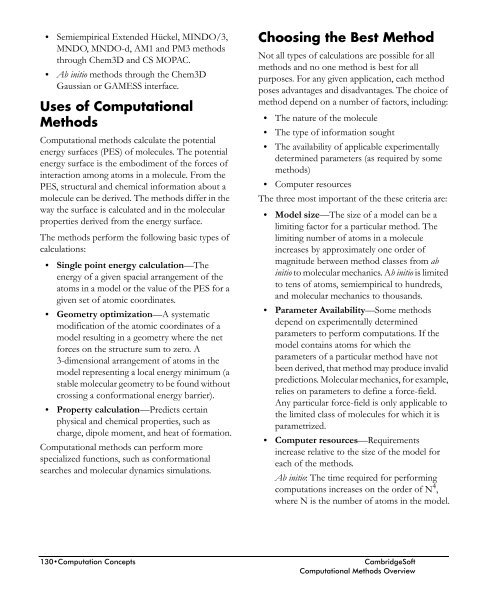Chem3D Users Manual - CambridgeSoft
Chem3D Users Manual - CambridgeSoft
Chem3D Users Manual - CambridgeSoft
You also want an ePaper? Increase the reach of your titles
YUMPU automatically turns print PDFs into web optimized ePapers that Google loves.
Administrator<br />
• Semiempirical Extended Hückel, MINDO/3,<br />
MNDO, MNDO-d, AM1 and PM3 methods<br />
through <strong>Chem3D</strong> and CS MOPAC.<br />
• Ab initio methods through the <strong>Chem3D</strong><br />
Gaussian or GAMESS interface.<br />
Uses of Computational<br />
Methods<br />
Computational methods calculate the potential<br />
energy surfaces (PES) of molecules. The potential<br />
energy surface is the embodiment of the forces of<br />
interaction among atoms in a molecule. From the<br />
PES, structural and chemical information about a<br />
molecule can be derived. The methods differ in the<br />
way the surface is calculated and in the molecular<br />
properties derived from the energy surface.<br />
The methods perform the following basic types of<br />
calculations:<br />
• Single point energy calculation—The<br />
energy of a given spacial arrangement of the<br />
atoms in a model or the value of the PES for a<br />
given set of atomic coordinates.<br />
• Geometry optimization—A systematic<br />
modification of the atomic coordinates of a<br />
model resulting in a geometry where the net<br />
forces on the structure sum to zero. A<br />
3-dimensional arrangement of atoms in the<br />
model representing a local energy minimum (a<br />
stable molecular geometry to be found without<br />
crossing a conformational energy barrier).<br />
• Property calculation—Predicts certain<br />
physical and chemical properties, such as<br />
charge, dipole moment, and heat of formation.<br />
Computational methods can perform more<br />
specialized functions, such as conformational<br />
searches and molecular dynamics simulations.<br />
Choosing the Best Method<br />
Not all types of calculations are possible for all<br />
methods and no one method is best for all<br />
purposes. For any given application, each method<br />
poses advantages and disadvantages. The choice of<br />
method depend on a number of factors, including:<br />
• The nature of the molecule<br />
• The type of information sought<br />
• The availability of applicable experimentally<br />
determined parameters (as required by some<br />
methods)<br />
• Computer resources<br />
The three most important of the these criteria are:<br />
• Model size—The size of a model can be a<br />
limiting factor for a particular method. The<br />
limiting number of atoms in a molecule<br />
increases by approximately one order of<br />
magnitude between method classes from ab<br />
initio to molecular mechanics. Ab initio is limited<br />
to tens of atoms, semiempirical to hundreds,<br />
and molecular mechanics to thousands.<br />
• Parameter Availability—Some methods<br />
depend on experimentally determined<br />
parameters to perform computations. If the<br />
model contains atoms for which the<br />
parameters of a particular method have not<br />
been derived, that method may produce invalid<br />
predictions. Molecular mechanics, for example,<br />
relies on parameters to define a force-field.<br />
Any particular force-field is only applicable to<br />
the limited class of molecules for which it is<br />
parametrized.<br />
• Computer resources—Requirements<br />
increase relative to the size of the model for<br />
each of the methods.<br />
Ab initio: The time required for performing<br />
computations increases on the order of N 4 ,<br />
where N is the number of atoms in the model.<br />
130•Computation Concepts<br />
<strong>CambridgeSoft</strong><br />
Computational Methods Overview











